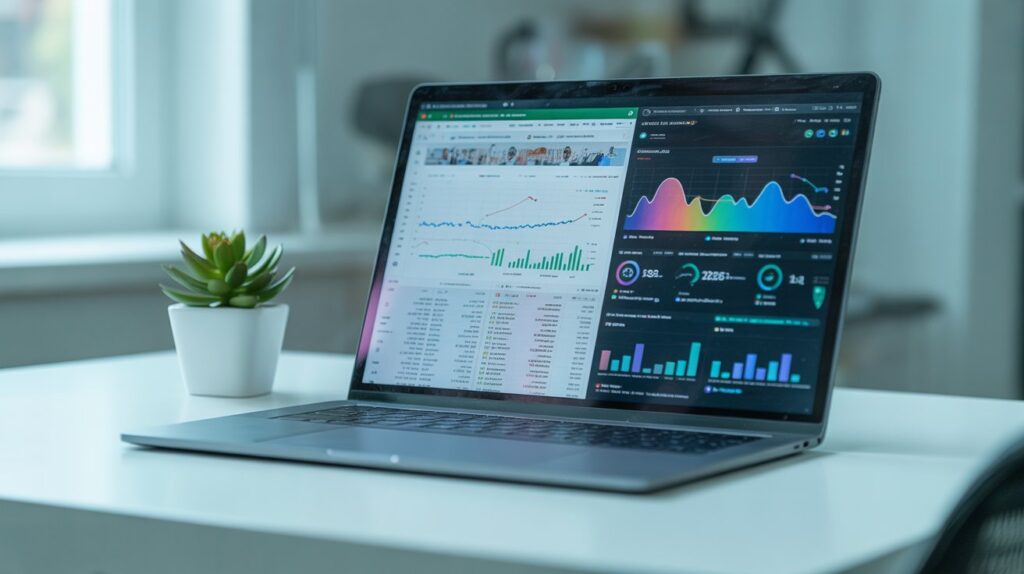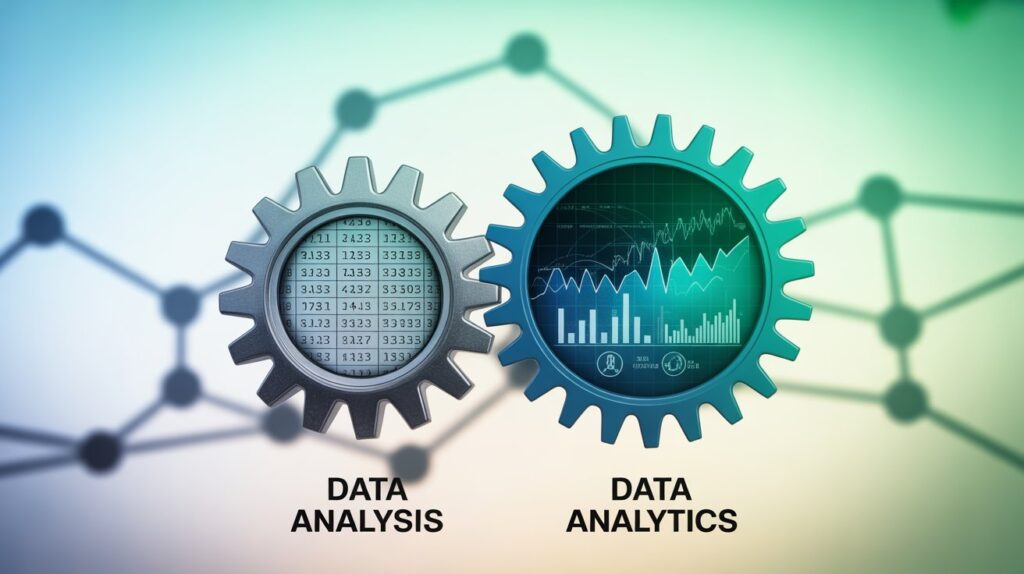
If you’re new to the world of data, you might hear people using the terms data analysis and data analytics as if they mean the same thing.
But while they sound similar, there’s actually an important difference between them.
In this article, I’ll explain everything in the simplest way possible. Even if you don’t have a tech background or barely know what data is, you’ll still be able to understand the differences between data analysis and data analytics.
Also, if you’re planning to start a career in this field, understanding these differences is a must.
It not only strengthens your foundation but also helps you choose the right industry to focus on.
Ready? Let’s start with a basic question:
What is Data?
Data is simply information — anything that can be recorded and stored so it can be used later.
It can be numbers, words, images, sounds… basically, facts about something.
Everyday examples of data:
- A grocery store’s daily sales numbers
- Your phone’s call history and contact list
- The weather forecast for the week
- Your fitness tracker’s steps count
- Photos you’ve taken (date, location, camera settings — all of that is data)
In the data industry, when people talk about “data,” they usually mean:
- Structured data → neatly organized in rows and columns (like an Excel sheet: dates, sales numbers, customer names)
- Unstructured data → messy or free-form (like emails, images, videos, tweets)
By itself, data is just raw facts. The magic happens when we use it to find meaning and make better decisions. That’s where data analysis and data analytics come in.
💡 Simple definition:
Data is raw information — just the facts, without analysis or meaning yet.
Once you examine it to find meaning, that’s data analysis.
Once you turn it into actions, that’s data analytics.
Now you have understand what data is and how it’s used for data analysis and data analytics.
What is Data Analysis?
Data Analysis is the process of examining raw data (facts, numbers, records, etc.) to discover useful information. It focuses on finding patterns, spotting trends, and answering specific questions.
👉 In other words, it helps us understand the past by looking at what has already happened.
Key Characteristics of Data Analysis:
- Focus: Understanding what happened
- Goal: Find insights in existing data
- Approach: Descriptive and diagnostic (it describes the past and sometimes explains why it happened)
- Outcome: Reports, charts, graphs, and observations
Types of Data Analysis:
- Descriptive Analysis → “What happened?”
Example: Last month’s sales increased by 20%. - Diagnostic Analysis → “Why did it happen?”
Example: Sales increased because of a holiday discount campaign.
Example in Daily Life:
Imagine you track your expenses for a month:
- Week 1: ₹2,000
- Week 2: ₹3,000
- Week 3: ₹4,500
- Week 4: ₹2,500
By analyzing this, you realize you spend more on weekends or on food delivery. That’s data analysis — looking at past records to understand spending patterns.
What is Data Analytics?
Data Analytics is broader and more advanced. It involves the entire process of working with data — from collecting and cleaning it, to analyzing it, predicting future outcomes, and recommending actions.
👉 In other words, it helps us understand the past, predict the future, and guide decision-making.
Key Characteristics of Data Analytics
- Focus: Understanding what happened, why it happened, what will happen, and what to do
- Goal: Support decision-making and strategy
- Approach: Uses advanced tools and techniques like statistics, predictive modeling, and machine learning
- Outcome: Actionable strategies, forecasts, and business improvements
Types of Data Analytics
- Predictive Analytics → “What is likely to happen next?”
Example: Predicting that online shopping will rise before festivals. - Prescriptive Analytics → “What should we do about it?”
Example: Suggesting to stock more products or run ads during that time.
Example in Daily Life
Using the same expense-tracking example:
- You don’t just see that you spent more on food delivery — you also predict that next month your expenses will go higher if you continue the habit.
- Then you take action, like setting a budget or cooking more at home.
That’s data analytics — using insights to plan and act.
Skills and Tools Required for Data Analysis and Data Analytics:
Skills for Data Analysis
- Basic Statistics & Math – To understand averages, percentages, and trends.
- Data Cleaning – Ability to spot and fix errors in datasets.
- Visualization Skills – Presenting data in charts and graphs so it’s easy to understand.
- Critical Thinking – Asking the right questions like “Why did this happen?”.
- Attention to Detail – Small mistakes in data can lead to wrong conclusions.
👉 Good starting point for beginners: Learn Excel or Google Sheets first.
Tools for Data Analysis
- Excel / Google Sheets – Perfect for beginners to analyze small datasets.
- SQL – To fetch and manage data from databases.
- Tableau / Power BI (basic use) – For creating easy-to-understand dashboards.
Skills for Data Analytics
- Advanced Statistics & Probability – Needed for predictions and forecasts.
- Programming Knowledge – Python or R for handling large datasets and building models.
- Machine Learning Basics – For predictive and prescriptive analytics.
- Business Acumen – Understanding how insights connect to real-world decisions.
- Problem-Solving Skills – Turning data insights into practical strategies.
👉 Good starting point for beginners: Learn SQL (for databases) and a visualization tool like Tableau or Power BI.
Tools for Data Analytics
- Programming Languages: Python, R (used for deeper analysis and machine learning).
- Business Intelligence Tools: Tableau, Power BI, QlikView.
- Big Data Tools: Hadoop, Spark (used when working with very large datasets).
- Machine Learning Libraries: Scikit-learn, TensorFlow (for predictive analytics).
Data Analysis vs Data Analytics (Quick Comparison)
| Feature | Data Analysis 🟢 | Data Analytics 🔵 |
|---|---|---|
| Scope | Narrow (a part of analytics) | Broad (includes analysis + more steps) |
| Focus | What happened? / Why did it happen? | What happened? / Why? / What will happen? / What should we do? |
| Goal | Find insights and explain past trends | Predict outcomes, guide decisions, and create strategies |
| Outcome | Reports, charts, graphs, insights | Forecasts, strategies, business improvements |
| Tools | Excel, Google Sheets, SQL, basic Tableau/Power BI | Python, R, Tableau, Power BI, Big Data tools, Machine Learning libraries |
| Required Skills | – Basic statistics & math – Data cleaning – Visualization skills – Critical thinking – Attention to detail | – Advanced statistics & probability – Programming (Python/R) – Machine learning basics – Business acumen – Problem-solving & decision-making |
Simple Way to Remember:
- Data Analysis = Looking at the rear-view mirror → understanding the road you’ve already traveled.
- Data Analytics = Driving with GPS → not only seeing where you are but also where you’re going and how to get there.
Data Analysis vs. Data Analytics – Which One Should You Choose for a Better Career?

If you’re thinking about starting a career in the data industry, one big question comes up quickly: Should you become a Data Analyst or go for Data Analytics as a career path?
Both sound similar, but they open up slightly different doors for your future. Let’s break it down in simple terms.
Starting Point: Data Analysis (Great for Beginners)
If you’re just entering the world of data, Data Analysis is often the best first step.
- It requires fewer technical skills in the beginning.
- You can start with Excel, Google Sheets, and SQL (which are not hard to learn).
- It helps you build a strong foundation in understanding data, finding insights, and creating reports.
- Most companies hire data analysts as an entry-level role.
👉 Career Path:
Data Analyst → Senior Data Analyst → Business Analyst → (then you can move into Data Analytics or Data Science later).
Going Beyond: Data Analytics (Future-Focused & High Demand)
Once you’re comfortable with data basics, you can move into Data Analytics.
- It involves deeper skills like Python/R, advanced statistics, machine learning, and data visualization tools.
- Companies rely on data analysts for reports, but they rely on data analytics for predictions and strategies.
- This field has broader career options, especially in industries like tech, finance, healthcare, and e-commerce.
👉 Career Path:
Data Analyst → Data Analytics Specialist → Data Scientist / Data Engineer → Analytics Manager
Which One Should You Choose?
- If you are new, non-technical, or switching careers, start with Data Analysis. It’s easier to learn, gives you practical job opportunities, and builds your confidence.
- If you already have some technical skills (coding, math, or statistics), or if you’re ambitious about AI, machine learning, and predictive analytics, then go for Data Analytics.
Final Thoughts!
While the terms Data Analysis and Data Analytics are often used interchangeably, they serve different purposes in the data world.
- Data Analysis is about looking back — finding patterns, identifying problems, and explaining what happened in the past.
- Data Analytics is about looking forward — using advanced techniques to predict trends, optimize strategies, and guide future decisions.
Think of it this way:
- If a company asks, “Why did our sales drop last month?” → That’s Data Analysis.
- If the company asks, “How can we increase sales next month?” → That’s Data Analytics.
Both are important, but they work at different levels. Data Analysis builds the foundation, while Data Analytics drives strategy and innovation.
So, if you’re starting your career, begin with analysis to master the basics, and then move toward analytics to future-proof your skills and open bigger career opportunities.
Some Best Data Analytics Courses I have Reviewed:


